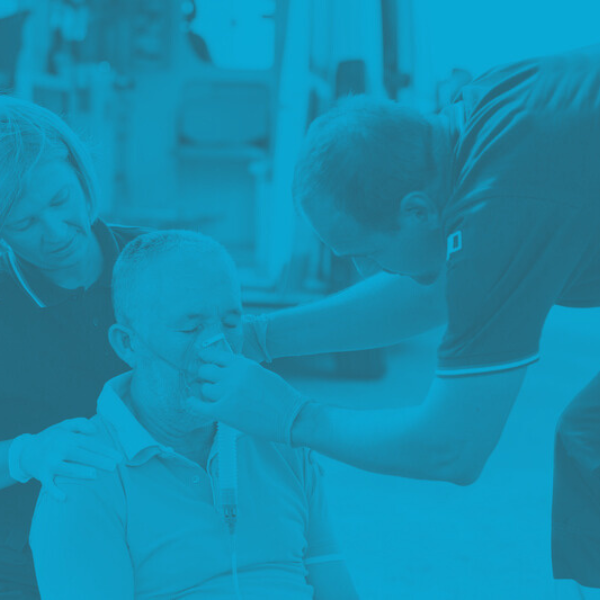Best Practices Post-Cardiac Arrest: ACLS Algorithm Standards
Best Practices Post-Cardiac Arrest: ACLS Algorithm Standards

by Greta Kviklyte
Life Saver, AMC
Co-authored by Kim Murray, RN, M.S.
posted on Nov 9, 2018, at 3:45 pm
Cardiac arrest is responsible for the deaths of 475,000 Americans annually, and up to 54 percent of those that suffer cardiac arrest outside of the hospital, approximately 350,000, do not receive the care necessary to live, reports the American Heart Association. While the location where cardiac arrest occurs plays a role in survival, actions taken by trained health care professionals, including the conduction of the ACLS survey, have an effect on mortality risk. The survey advises a series of steps to encourage a return of spontaneous circulation (ROSC) through the treatment of reversible causes of arrest.
We offer Online ACLS Certification and Renewal
Health care professionals can use the ACLS algorithm’s standards to reduce the conditions associated with poor outcomes. Such action also increases the likelihood of positive outcomes by establishing full plans of care, such as comprehensive neurological, cardiovascular and respiratory care, as well as innovative treatment measures, like induced hypothermia to preserve tissue and brain function.

Conditions Associated With Poor Treatment Outcomes Following Cardiac Arrest
The administration of bystander CPR and ACLS in the hospital setting has a dramatic effect on chance of survival. When performed immediately after cardiac arrest, survival chance triples. Unfortunately, up to 90 percent of those experiencing cardiac arrest outside of a hospital lose their lives. Even those that do survive and manage to get proper treatment are not out of the proverbial woods.
While proper care lessens mortality risk, health problems may still lead to subsequent cardiac arrest and poor outcomes. In addition to death, poor outcomes include any potential outcome that results in severe degradation of quality of life.
For example, brain damage resulting from cardiac arrest could impair mobility, speech and memory. Furthermore, certain factors increase the likelihood of poor outcomes. As explained by BioMed Central, these conditions include:
- Older age. The elderly have a heightened risk of poor outcomes after cardiac arrest due to co-occurring health conditions that may result in additional injury or health problems. Chronic heart failure, poor cholesterol, failure to take medications as prescribed and other factors prevalent in the elderly increase the risk of poor outcomes.
- Suffering cardiac arrest while at home. The gravest risk for poor outcomes outside of the hospital involves the occurrence of cardiac arrest while at home, and the risk is heightened among those that live alone. When someone suffers arrest at home, the chances of getting professional care are diminished, further increasing risk of death or permanent injury.
- Entering cardiac arrest with a rhythm aside from ventricular fibrillation or ventricular tachycardia. Heart rhythm also affects survival chances when cardiac arrest occurs. This is the result of a shockable or non-shockable rhythm, and therefore, it is also indicative of whether medications can be administered. Since ventricular fibrillation and ventricular tachycardia are the two shockable rhythms in the ACLS algorithm, exhibiting a non-shockable rhythm, such as asystole or pulseless electrical activity (PEA), results in a longer time to ROSC.
- Longer duration of no blood flow. The time between onset of cardiac arrest and the initiation of chest compressions or ROSC is related to treatment outcomes. As more time passes without blood flow, oxygen supply to the brain and vital organs is expended. Therefore, tissue death occurs.
- Longer duration of low blood flow. Even when CPR and ACLS are initiated properly, the time between cardiac arrest and initiation of chest compressions may lead to a poor blood flow. The whole point of CPR is to provide enough circulation for the body and vital organs to get enough oxygen to survive until ROSC or the cause is addressed. If someone performs low-quality chest compressions, i.e. not allowing for recoil of the chest or failure to achieve the proper compression-depth, likelihood of poor outcomes increases.
- Administration of epinephrine (adrenaline).There has been an ongoing struggle regarding the administration of epinephrine and its effect on cardiac arrest. While the algorithm details the administration of epinephrine after performing CPR for at least two minutes, some health care facilities may have protocols that call for the administration of epinephrine earlier than advised. It is the early administration of epinephrine that is most commonly associated with poor treatment outcomes.
- Absence of corneal and pupillary reflexes. Since corneal and pupillary reflexes are indicative of proper neurofunction, absence of these reflexes may allude to brain injury or other significant problems.
- Having a Glasgow Coma Scale score of 1. Having a score of 1 on the Glasgow Coma Scale for more than 20 minutes after ROSC is associated with poor outcomes as well.
- Having a low pH level. A low pH level correlates to blood glucose levels, lactate, low blood flow and poor oxygen perfusion.
- A PaCO2 of less than 45 kPa. Abnormal partial pressure of carbon dioxide in arterial blood may allude to a potential problem with the diffusion of oxygen across cellular membranes within the lungs. Moreover, it may indicate a potential problem with blood flow to and from the lungs as well.
Although these conditions may indicate a poor outcome on the horizon, differentiating factors in each case should be taken into consideration in preparing a plan of care following cardiac arrest.
ACLS Algorithm Standards Increase Likelihood of Positive Outcomes
 Adherence to ACLS protocols throughout and following cardiac arrest are tied to positive outcomes. According to NCBI.NLM.NIH.gov, the percentage of ACLS steps adhered to is an accurate predictor of ROSC, regardless of location where arrest occurred and age. Since the conditions in the aforementioned list are heavily dependent on the time delay between cardiac arrest and providing emergency care, positive outcomes are most associated with adherence to ACLS standards.
Adherence to ACLS protocols throughout and following cardiac arrest are tied to positive outcomes. According to NCBI.NLM.NIH.gov, the percentage of ACLS steps adhered to is an accurate predictor of ROSC, regardless of location where arrest occurred and age. Since the conditions in the aforementioned list are heavily dependent on the time delay between cardiac arrest and providing emergency care, positive outcomes are most associated with adherence to ACLS standards.
For example, eight of the 10 conditions listed above are related to the time delay between cardiac arrest and initiation of care. Suffering a cardiac arrest while outside of the hospital may result in poor blood flow, leading to a decrease in pH levels, lower partial carbon dioxide levels, greater duration of lost consciousness and brain injury.
Age and location are relevant due to the likelihood of older individuals to have ready access to emergency care, such as living in a retirement community or being otherwise located in a health care facility. Therefore, adherence to ACLS standards successfully reduces risk of poor outcomes in at least eight of the top situations that are associated with poor outcomes. This is the result of timely, high-quality compressions, appropriate medication administration and treatment of the causes of arrest.
Best Practices After Cardiac Arrest
After ROSC, the right care interventions can further reduce the risk of poor outcomes by reducing tissue damage and preventing a cause of cardiac arrest from recurring. These best practices, asserts ECCGuidelines.Heart.org, include:
1. Cardiovascular Care
Proper cardiovascular care includes obtaining a 12-lead EKG to determine ST elevation presence, administration of a coronary angiography for those with ST elevation, maintaining an appropriate blood pressure and administration of vasopressors to support sustained cardiac output.
It is also prudent to examine a person for any potential signs of internal bleeding, conduct appropriate blood tests, such as a CBC and CMP, and monitor vital signs frequently. In some cases, an arterial line may be inserted to provide around-the-clock monitoring of blood pressure, which is common in intensive care units.
Depending on the cause of arrest, such as hypovolemia or acidosis, additional interventions may be necessary. For example, someone suffering a traumatic injury that resulted in blood loss may require the administration of blood products to restore blood volume.
2. Neurologic Care
Neurologic care is often overlooked as the person that suffered cardiac arrest is routinely sedated. However, brain injury contributes to the cause of death in 68 percent of patients after out-of-hospital arrest and 23% after in-hospital arrest. Health care professionals should watch for the signs of potential brain injury, including coma, seizures, neurocognitive dysfunction and brain death.
If any of these indicators exist, monitoring brain activity via an EEG is the best practice. Additionally, the onset of seizures requires medication treatment to reduce their occurrence, thereby reducing the likelihood of long-term brain damage.
Upon return of consciousness, health care professionals should evaluate cognitive functions by checking for corneal and pupillary reflexes, communication with the patient, if possible, and range of motion in the extremities.
3. Respiratory Care
Respiratory care is a delicate issue in the aftermath of cardiac arrest. A chest X-ray may be necessary to ensure proper placement of an ET tube, and monitoring of blood gases may also improve quality of care. The AHA recommends maintain a PaCO2 level of 35-45 mmHg). However, the use of other treatment options that affect respiratory rate, such as lowering of the body temperature through induced hypothermia, may affect PaCO2 levels.
In such cases, laboratory values will skew higher than actual PaCO2 readings for those with a body temperature below normal. Following cardiac arrest, pulmonary treatment should also include addressing any other causes of cardiac arrest, such as treating breathing problems with an appropriate medication via nebulizer.
4. Pulmonary Embolism Treatment
If the cause of cardiac arrest can be narrowed to a pulmonary embolism, also known as a pulmonary thrombosis (notice the “T” from the list of reversible causes), it should be treated as soon as possible.The preferred treatment is administration of fibrinolytics. Some may argue against this approach due to a perceived bleeding risk. However, the administration of life-saving support does not appear to have an effect on bleeding risk when fibrinolytics are used afterward. The AHA also recommends their use in both presumed and known cases involving pulmonary emboli.
5. Sedation to Reduce Stress and Agitation
Intubation is an extremely common practice to ensure proper ventilation and oxygenation following cardiac arrest. For those that are unable to tolerate the sensation of the ET tube, sedation may be used to achieve a desired level of comfort. In addition, people post-cardiac arrest with cognitive dysfunction may be candidates for sedation to reduce risk of self-injury or purposeless movements.
6. Targeted Temperature Management
The final best practice following cardiac arrest was originally recommended for those that typically experience out-of-hospital ventricular fibrillation or pulseless ventricular tachycardia in a prolonged, more than 20 minutes, comatose state. However, anyone that suffers cardiac arrest with a non-shockable rhythm, regardless of the location in which the event took place, may benefit from Targeted Temperature Management (TTM), provided they are in a comatose state.
Also known as induced hypothermia, TTM involves lowering the body temperature to between 32 C and 36 C within six hours of cardiac arrest. Achieving the reduced body temperature is typically achieved through a cooling-like machine, such as an “Arctic Sun.” The machine circulates cooled water through pads attached to zones on the person’s body. The Arctic Sun acts as both initiator and maintainer of an appropriate body temperature through the use of a temperature probe.
The probe is located within the tip of a urinary catheter, which provides a consistent measure of internal body temperature. Also, the temperature is measured every two seconds to further reduce risk of injury or lowering the temperature past the recommended threshold.
After at least 24 hours of TTM, a rewarming phase begins. This involves the gradual increase of body temperature to restore a normal core temperature. If the person regains consciousness during this phase, sedation is necessary for comfort. Also, sedation helps to suppress shivering, ensuring a proper, gradual return to the correct body temperature.
Even with proper neurologic, respiratory and cardiovascular care, as well as proper sedation techniques and more invasive treatment measures, if necessary, remember the use of TTM is still relatively new. Any treatment plan that prescribes the use of TTM should be initiated within the 6-hour window after arrest and not enter the rewarming phase earlier than recommended.
Furthermore, depending on the capabilities of your facility, never initiate TTM without the ability to monitor change in body temperature automatically and frequently, as well as ensure maximum quality of care. This is especially important since TTM can result in additional tissue damage when not properly managed.
Comprehensive care to reduce the long-term impact on body systems is the goal of all treatment measures following cardiac arrest. These six practices reflect the need to address the key systems affected by cardiac arrest that may impact quality of life.
Everything Goes Back to Preventing the Recurrence of Cardiac Arrest
In a sense, health care professionals work together to reduce the likelihood of recurrence of a cause of cardiac arrest. Reversible causes of arrest may be the easiest to treat, but accidents, age and other factors can precipitate cardiac arrest. By understanding the ACLS algorithm standards and their impact on care after cardiac arrest, health care professionals can increase survival chances, as well as improve a person’s quality of life.
Have you ever been confused about the best type of care following cardiac arrest? Share your thoughts and experiences along with this article to social media today. Also, remember to enroll in the appropriate life-saving skills course to help you prevent the causes of arrest in those under your care as well.



